Luận án Nutritive improvement of cassava root and its utilisation in taro foliage and banana stems basal diets for local pig production in smallholders in lao PDR
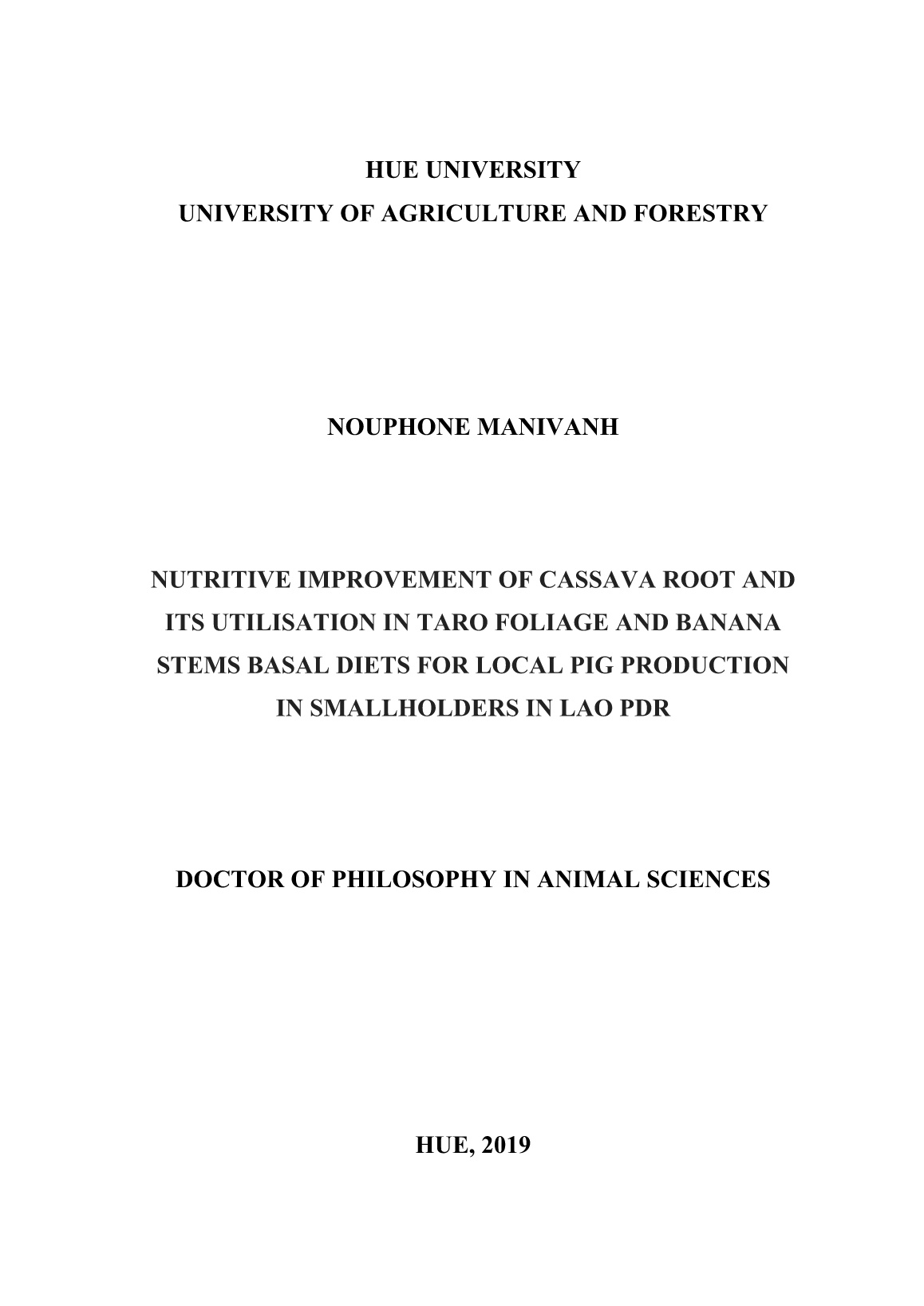
Trang 1
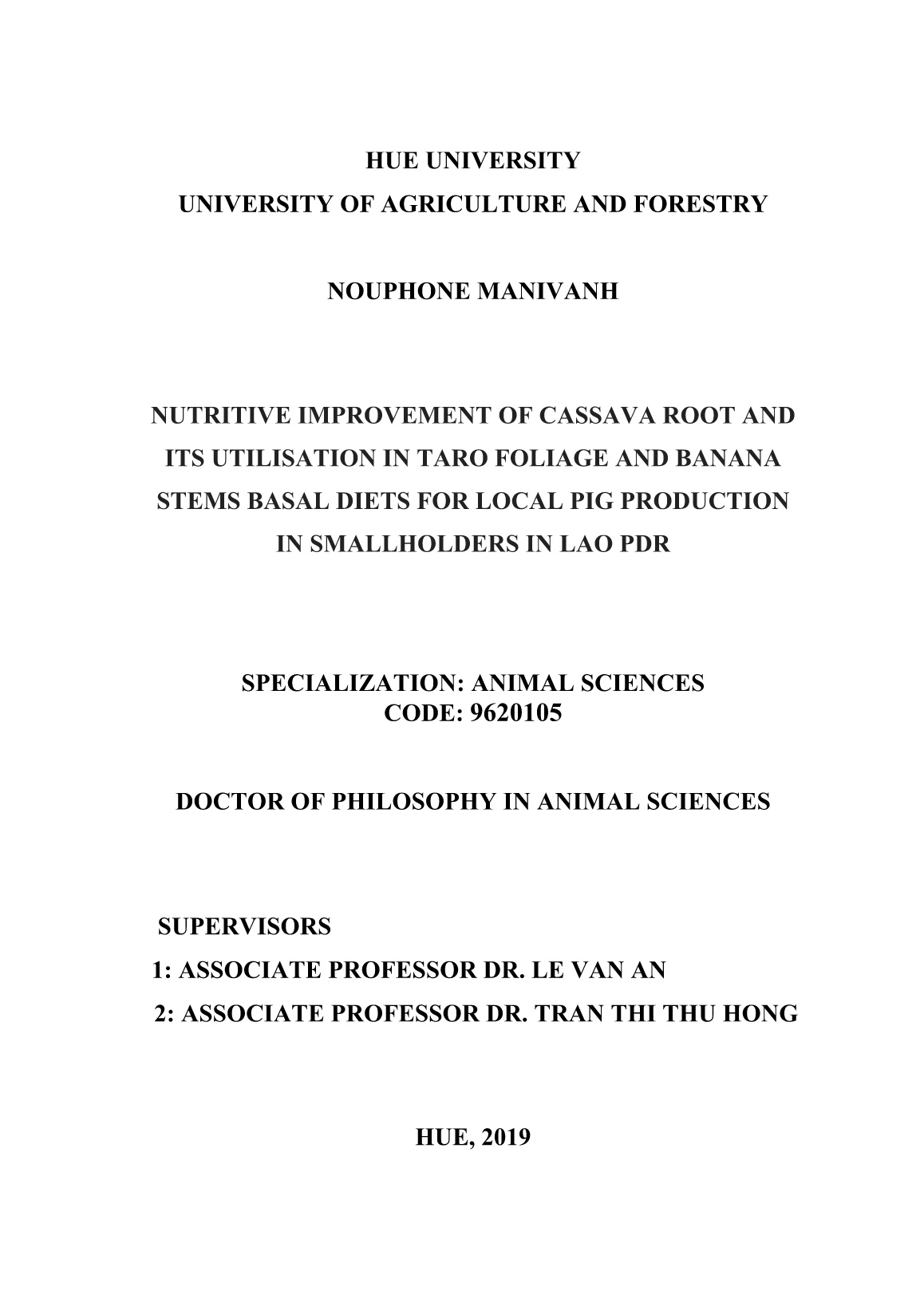
Trang 2
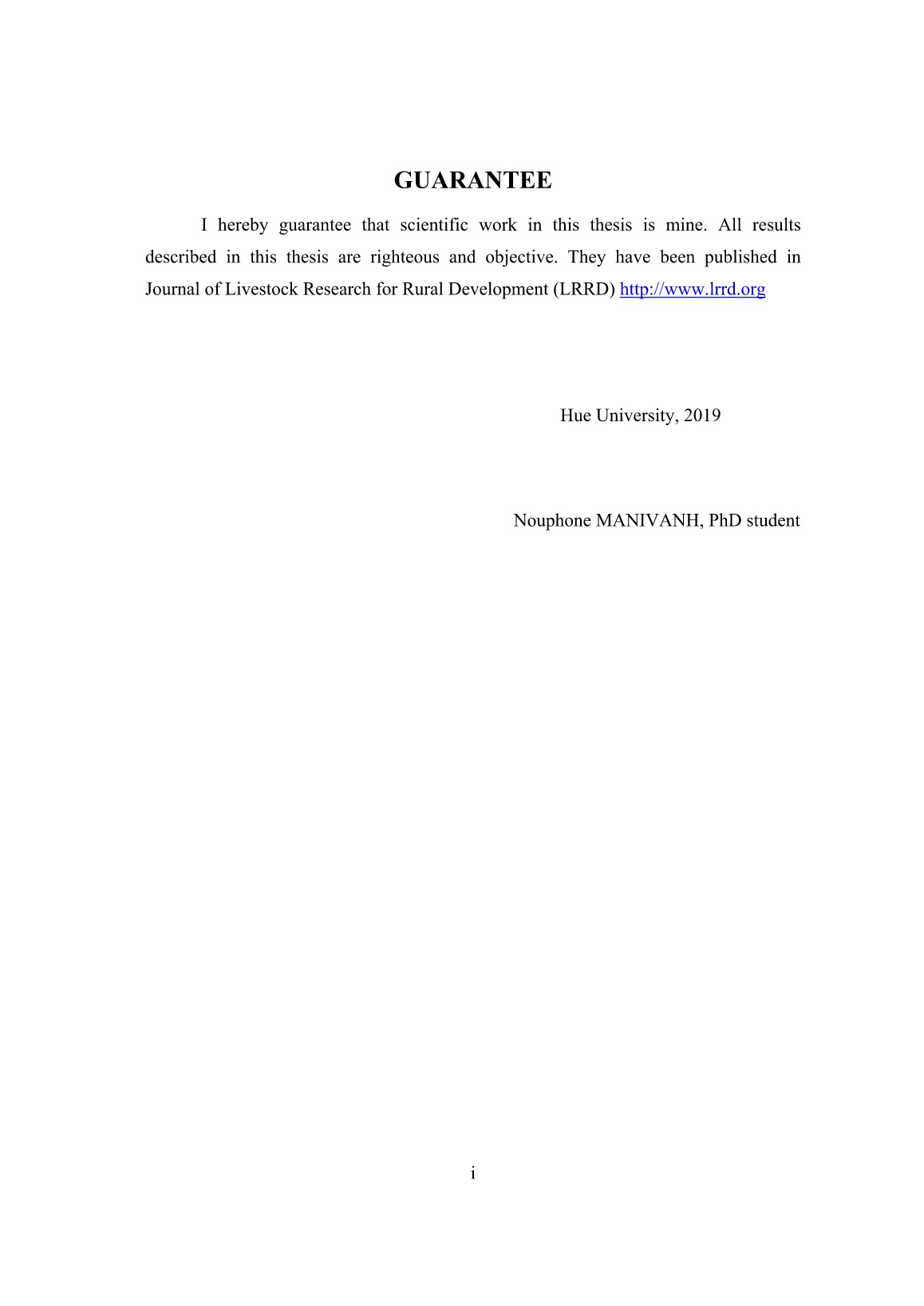
Trang 3

Trang 4
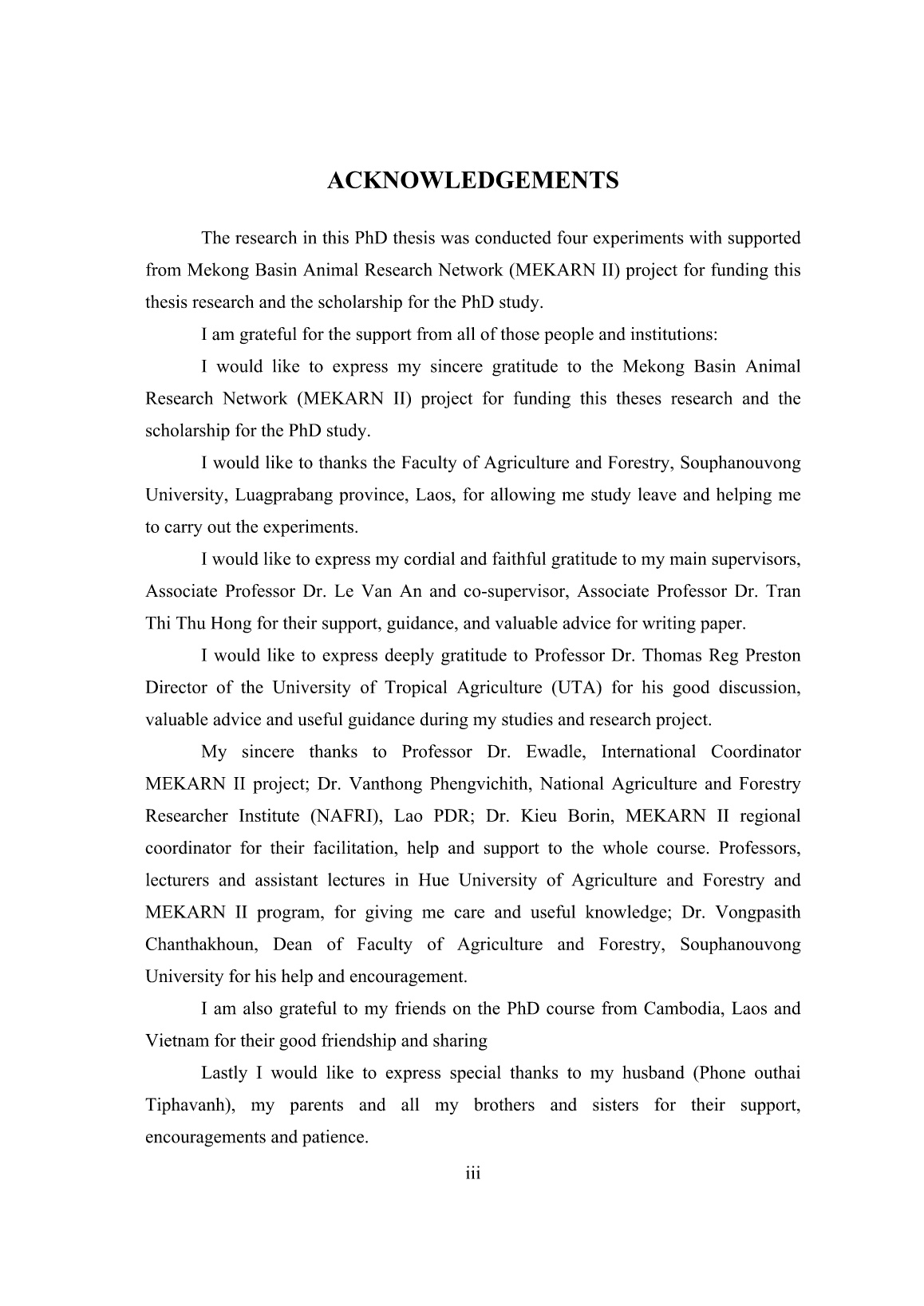
Trang 5
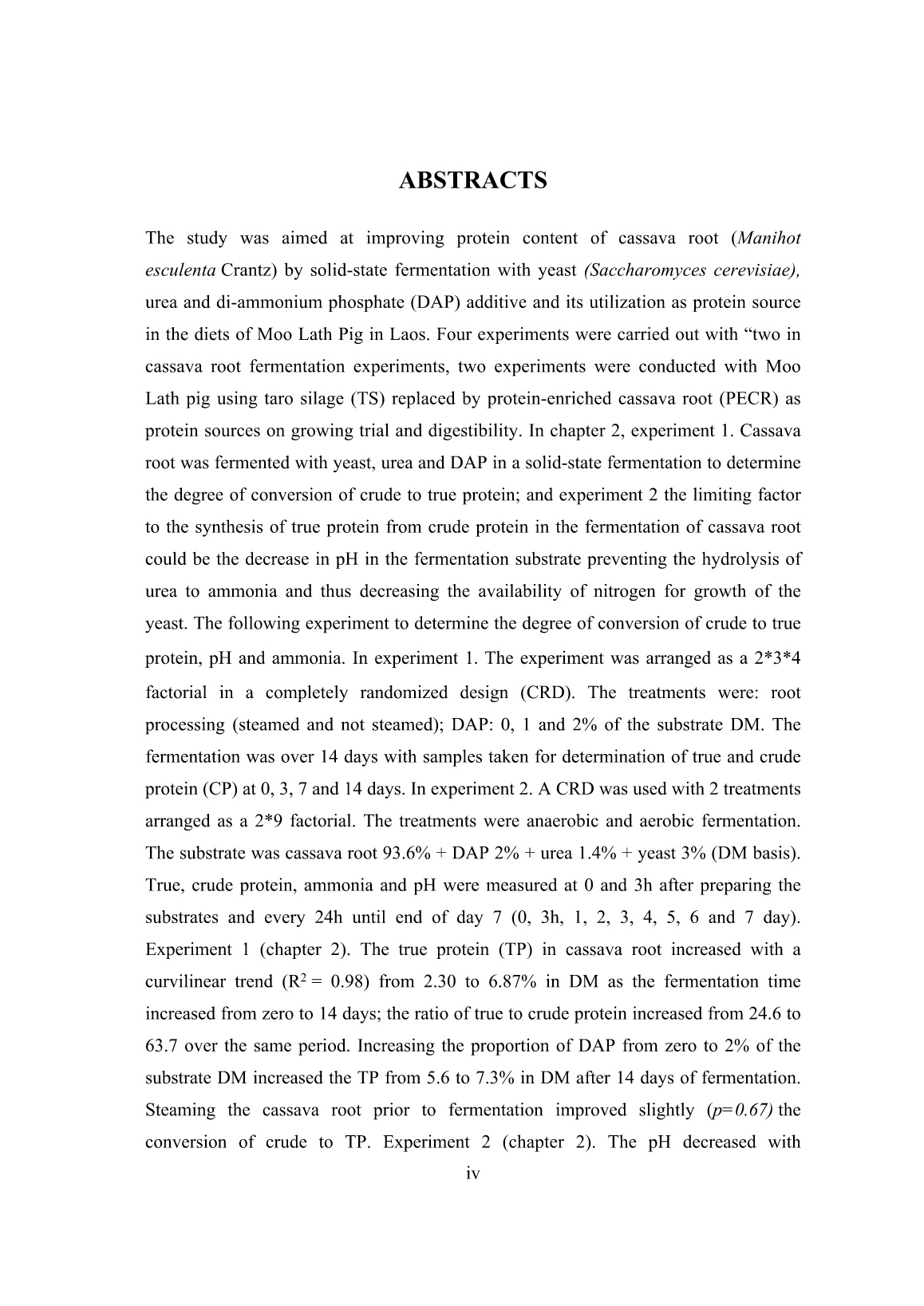
Trang 6
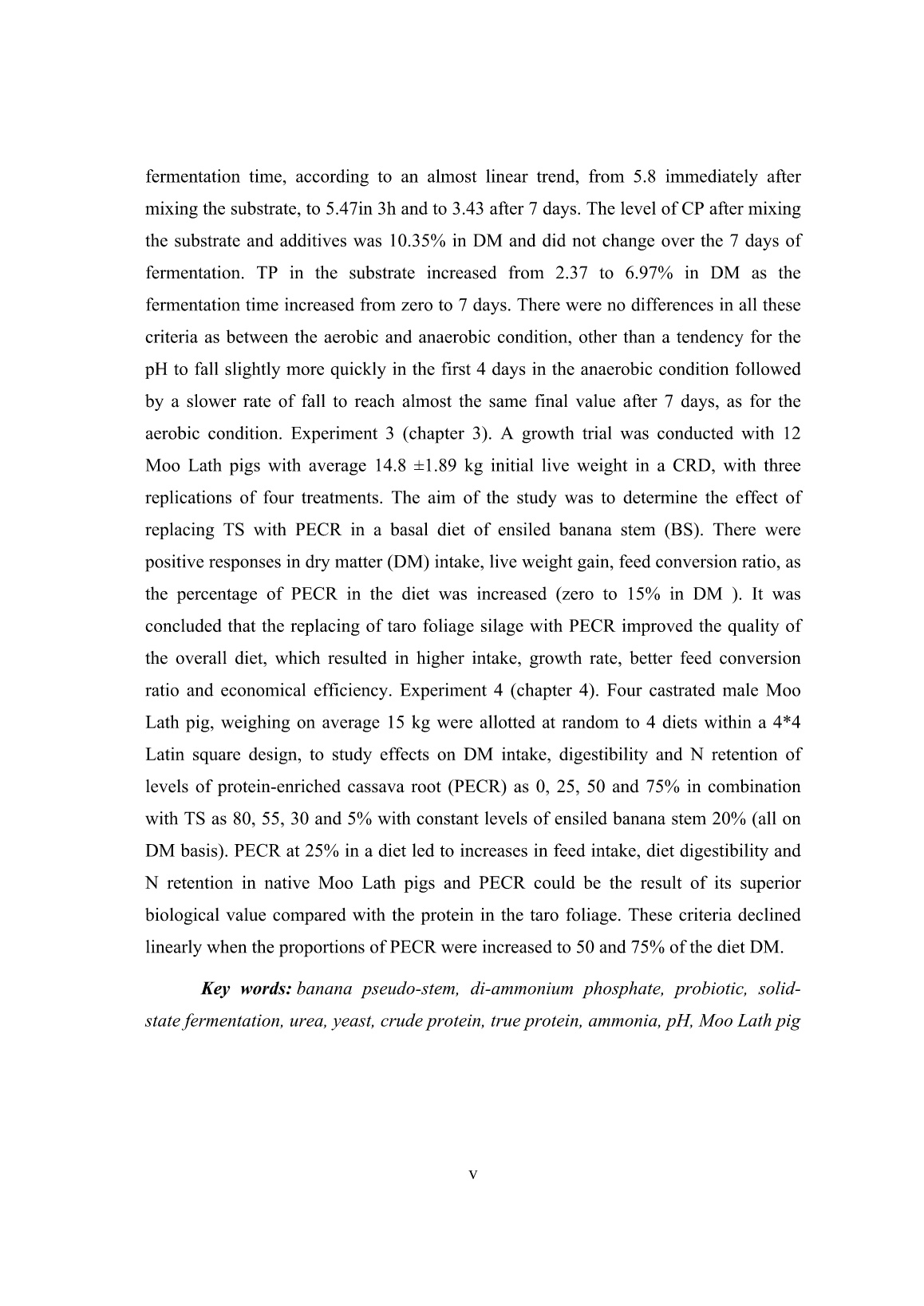
Trang 7
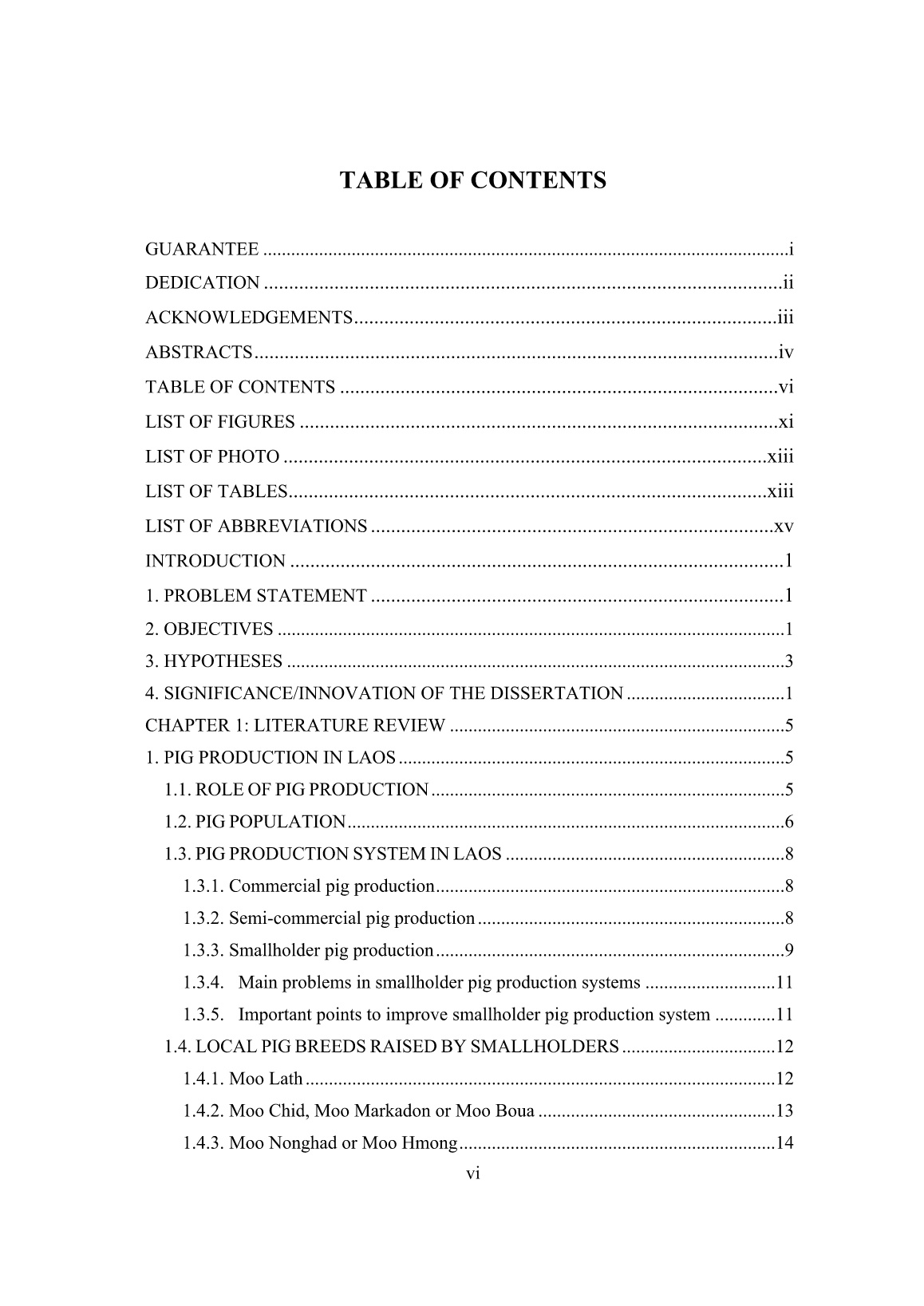
Trang 8
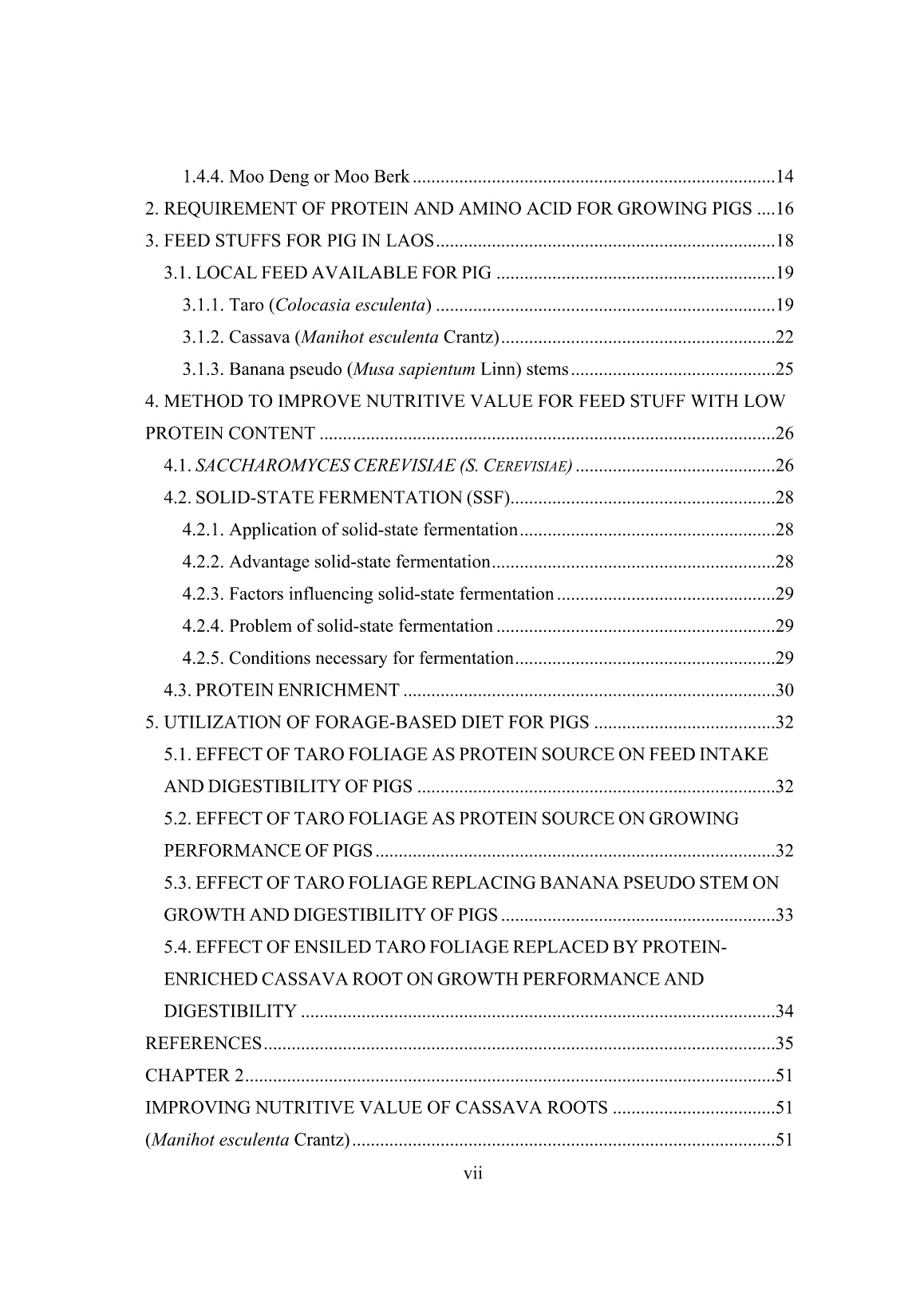
Trang 9
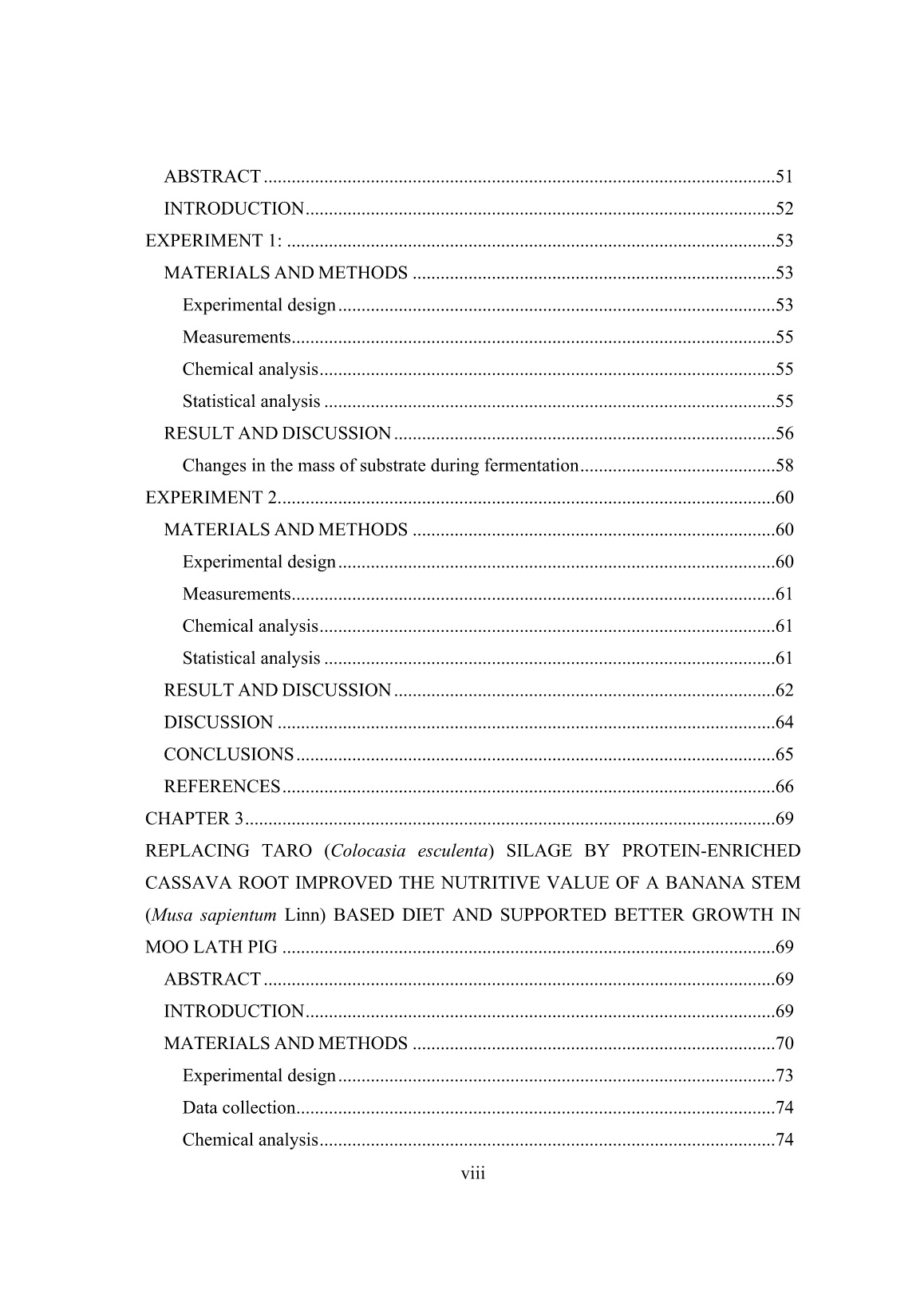
Trang 10
Tải về để xem bản đầy đủ
Bạn đang xem 10 trang mẫu của tài liệu "Luận án Nutritive improvement of cassava root and its utilisation in taro foliage and banana stems basal diets for local pig production in smallholders in lao PDR", để tải tài liệu gốc về máy hãy click vào nút Download ở trên.
Tóm tắt nội dung tài liệu: Luận án Nutritive improvement of cassava root and its utilisation in taro foliage and banana stems basal diets for local pig production in smallholders in lao PDR
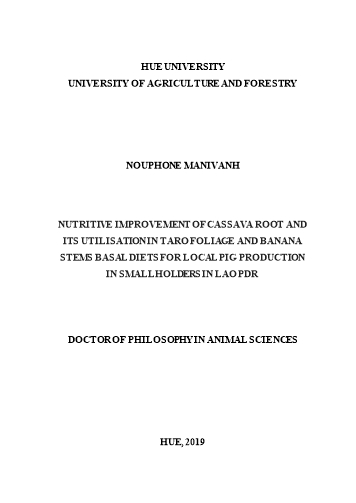
Requirement of Domestic Animals. National Academy Press, Washington, DC. N.R.C., 2012. National Research Council. 11. Washington, USA: National Academy Press; 2012. Nutrient Requirements of Swine. Ngo Huu Toan. and Preston, T.R., 2007. Evaluation of uncultivated vegetables for pigs kept in upland households. Livestock Research for Rural Development. Volume 19, Article #150. Ngo Thuy Bao Tran. and Brian, O., 2005a. Surveys on small-scale urban and periurban livestock production in Chau Doc Town. Master thesis. Ngo Thuy Bao Tran. and Brian, O., 2005b. Surveys on small-scale urban and periurban livestock production in Long Xuyen City. Master thesis. Noonan, S.C. and Savage, G.P., 1999. Oxalate content of foods and its effect on humans. Asia Pacific Journal of Clinical Nutrition, 8 (1), 64-74. Naji, S.A., Al-Ani, I.A., AL-Dhanqi, Z.T., Menati, J.K. and Al-Hety, H. E., 2007. The effect of using different treatments to suppress the deteriorates effects of aflatoxicosis on broiler performance. Iraqi Journal Poultry Science, (2), 1-16. Obadina, A.O., Oyewole, O.B., Sanni, L.O. and Abiola, S., 2006. Fungal enrichment of cassava peels proteins. African Journal of Biotechnology. Volume 5. No. 3, 302 - 304. Oboh, G. and Akindahunsi, A.A., 2005. Nutritional and toxicological evaluation of Saccharomyces cerevisiae fermented cassava flour. Journal of Food Composition and Analysis, Volume.18, pp.731 - 738 Okigbo, B.N., 1980. Nutritional implication of projects giving high priority of the production of staples of low nutritive quality. In the case of cassava (Manihont esculenta, Crantz) in the humid tropics West Africa. Journal of Food Nutrient Bull, 2:1 - 10. Onilude, A., 1996. Effect of cassava cultivar, age and pretreatment processes of cellulase and xylanase production from cassava waste by Trichoderma harzanium. Journal Basic Microbiology, (36), 421-31. Oosterwijk, G., Van Aken, D. and Vongthilath., 2003. A manual on Improved Rural Pig Production (1st Edition, English Language). Department of Livestock and Fisheries, Ministry of Agriculture and Forestry, Vientiane, Lao PDR VIII + 113 pp. Page 21, from: Oriol, E., Schettino, B., Viniegra-Gonzalez, G. and Raimbault, M., 1988. Solid state culture of Aspergillus niger on support. Journal of Fermentation Technology, (66), 57-62. Oscarsson, K.V. and Savage, G.P., 2006. Composition and availability of soluble and insoluble oxalates in raw and cooked taro (Colocasia esculenta var. Schott) leaves. Food Chemistry, 101 (2), 559 - 562. Onifade, A.A. and Babatune, G.M., 1996. Supplemental value of dried yeast in a high fiber diet for broiler chicks. Animal. Feed Science. Technology, (62), 91 - 96. Pham Sy Tiep., Luc, N.V., Tuyen, T.Q., Hung, N.M .and Tu, T.V., 2006. Study on the use of Alocasia macrorrhiza (roots and leaves) in diets for crossbred growing pigs under mountainous village conditions in northern Vietnam. Workshop-seminar “Forages for Pigs and Rabbits” MEKARN-CelAgrid, Phnom Penh, Cambodia, 22-24 August, 2006. Pham, K.T., Hoang, N.D., Duc, N.L., Hendricks, W.H., Van de Peet-Schwering, C.M.C. and Verstegen, M.W.A., 2010. Effect of genotype and dietary protein level on growth performance and carcass characteristics of fattening pigs in Central Vietnam. Asian-Australian Journal of Animal Science, 23 (8), 1034 - 104.2. Pagan, J.D., 1990. Effect of yeast culture supplementation on nutrient digestibility in mature horses. Journal. Animal. Science, 68:1. Pheng Buntha., Borin, K., Preston, T.R. and Ogle, B., 2008. Survey of taro varieties and their use in selected areas of Cambodia. Livestock Research for Rural Development. Volume 20, supplement. Retrieved June 29, 2009, from Phengsavanh, P. and Stur, W., 2006. The use and potential of supplementing village pigs with Stylo santhesguianensis in Lao PDR. Workshop-seminar "Forages for Pigs and Rabbits" MEKARN-CelAgrid, Phnom Penh, Cambodia, 22-24 August, 2006. Article # 14. Retrieved November 8, 115, from Phengsavanh, P., Ogle, B., Stur, W., Frankow-Lindberg, B.E. and Jan Erik Lindberg, J. K., 2010. Feeding and performance of pigs in smallholder production systems in Northern Lao PDR Phengsavanh, P., Ogle, B., Stur, W.E.F-L.B. and Lindberg, J.E., 2011. Smallholder Pig Rearing Systems in Northern Lao PDR. The Asian Australasian Journal of Animal Science 24(Doi: 10.5713/ajas.2011.10289), 6:867-874.Technical Report No. 10, August 1997, Lao Swedish Forestry Program, Louang prabang, Lao PDR. Press. Washington, D.C. Phiny, C., Preston, T.R., Borin, K. and Thona, M., 2012. Effect on growth performance of crossbred pigs fed basal diet of cassava root meal and ensiled taro foliage supplemented with protein-enriched rice or fish meal. Livestock Research for Rural Development. Volume 24, Article #65. Retrieved August 9, 2018, from Phong, N.V., Ly, N.T.H., Nhac, N.V. and Hang, D.T., 2013. Protein enrichment of cassava by-products using Aspergillus niger and feeding the product to pigs. Livestock Research for Rural Development. Volume 25, Article #130. www.lrrd.org/lrrd25/7/hang25130.htm Polyorach, S., Wanapat, M. and Wanapat, S., 2013. Enrichment of protein content in cassava (Manihot esculenta Crantz) by supplementing with yeast for use as animal feed. Emirates Journal Food Agriculture 2013, (25), 142 - 149. Preston, T.R., 2001. Potential of cassava in integrated farming systems. International Workshop Current. Research and Development on Use of Cassava as Animal Feed, Khon Kaen, Thailand July 23-24, 2001. Preston, T.R., 2006. Forages as protein sources for pigs in the tropics. Workshop-seminar "Forages for Pigs and Rabbits" MEKARN-CelAgrid, Phnom Penh, Cambodia, 22-24 August, 2006. Article #2 Retrieved June 7, 2007, from Quinteros, A., Farre, R. and Lagarda, M.J., 2003. Effect of cooking on oxalate content of pulses using an enzymatic procedure. International Journal of Food Sciences and Nutrition, (54), 373 - 377. Raemaekers, R.H., 2001. Crop production in tropical Africa, 23 - 45, 221 - 229. Rawel, H.M. and Kroll, J., 2003. Importance of cassava (Manihot esculenta Crantz) as the main staple food in tropical countries. DLR, (99), 102 – 110. Riethmuller, P., Hoffmann, D. and Chalermpao, N., 2002. Some Issues Associated with the Livestock Industries of the Asia-Pacific Region. Food and Agriculture Organization of the United Nations, Regional Office for Asia and the Pacific (APHCA). Rodríguez, L. and Preston, T.R., 2009. A note on ensiling the foliage of New Cocoyam (Xanthosoma sagittifolium). Livestock Research for Rural Development. Volume 21, Article #183. Rodríguez, L., Lopez, D., Preston, T.R. and Peters, K., 2006. New Cocoyam (Xanthosoma sagittifolium) leaves as partial replacement for soya bean meal in sugar cane juice diets for growing pigs. Workshop on Forages for Pigs and Rabbits, Phnom Penh, 22-24 August 2006. Roussos, S., Raimbault, M., Prébois, J.P. and Losane, B.K., 1993. Zymotis, large scale solid state fermenter: design and evaluation. Applied Biochemistry and Biotechnology, (42), 37 - 52. Safo Kantaka, O., 2004. Colocasia esculenta (L.) Schott. Record from Protabase. Grubben, G.J.H. & Denton, O.A. (Editors). PROTA (Plant Resources of Tropical Africa/ Ressources végétales de l’Afrique tropicale), Wageningen, Netherlands. Savage, G.P., Mảrtenson, L. and Sedcole, J.R., 2009. Composition of oxalate in baked taro (Colocasia esculenta var. Schott) leaves cooked alone or with addition of cows milk or coconut milk. Food Composition and Analysis, (22), 83 - 86. Savage, G.P., Vanhanen, L., Mason, S.M. and Ross, A.B., 2000. Effect of cooking on the soluble and insoluble content of some New Zealand foods. Journal of Food Composition and Analysis, 13 (3), 201 - 206. Sengxayalth, P. and Preston, T.R., 2017a. Fermentation of cassava (Manihot esculenta Crantz) pulp with yeast, urea and di-ammonium phosphate (DAP). Livestock Research for Rural Development. Volume 29, Article #177. RetrievedAugust 17, 2018, from Sengxayalth, P. and Preston, T.R., 2017b. Effect of protein-enriched cassava pulp on growth and feed conversion in Moo Laat pigs. Livestock Research for Rural Development. Volume 29, Article #178. Retrieved August 17, 2018, from Serra, A., et al.., 2005. Influence of temperature and pH on Saccharomyces bayanus var. uvarum growth; impact of a wine yeast interspecific hybridization on these parameters. International Journal Food Microbiol, 104 (3), 257 - 65. Sivilai, B. and Preston, T.R., 2017. Effect of level of dietary protein on growth and feed conversion of Moo Lath pigs fed a mixture of ensiled taro foliage (Colocasia esculenta) and of ensiled banana pseudo-stem (Musa spp). Livestock Research for Rural Development. Volume 29, Article #34. Retrieved August 13, 2018, from Sivilai, B. and Preston, T.R., 2017b. A low concentration of rice distillers’ byproduct, or of brewers’ grains, increased diet digestibility and nitrogen retention in native Moo Lath pigs fed ensiled banana pseudo-stem (Musa spp) and ensiled taro foliage (Colocasia esculenta). Livestock Research for Rural Development. Volume 29, Article #123. Sivilai, B., Preston, T.R. and Kaensombath, L., 2016. Feed intake, nutrient digestibility and nitrogen retention by Moo Lath pigs fed ensiled banana pseudo-stem (Musa spp) and ensiled taro foliage (Colocasia esculenta). Livestock Research for Rural Development. Volume 28, Article #6. Retrieved August 13, 2018, from Sivilai, B., Preston, T.R., Hang, D.T. and Linh, N.Q., 2018. Effect of a 4% dietary concentration of rice distillers’ byproduct, or of brewers' grains, on growth rate and feed conversion during pregnancy and lactation of native Moo Lath gilts and their progeny. Livestock Research for Rural Development. Volume 30, Article #20. Steinfeld, H., 1998. Livestock production in the Asia and Pacific region, current status issues and trends. In: hursey BS (ed), World Animal Review 90-1998/81. Animal Production and health Division, FAO (Food and Agriculture Organization of the United Nations), Rome, Italy. Soufi, M.A.A., 2005. Purification, Characterization and Utilization of (G6PD) From Locally Isolated Yeast Saccharomyces cerevisiae. Ph.D. thesis, Collage of Agriculture, University of Baghdad. Santin, E., Maiorka, A., Macari, M., Grecco, M., Sanchezi, J.C., Okada, T.M. and Myasaka, A.M., 2001. Performance and intestinal mucosa development of broiler chickens fed diets containing Saccharomyces cerevisiae cell wall. Journal. Apply Poultry Research, (10), 236 - 244. Tai, S.L., Daran-Lapujade, P., Walsh, M.C., Pronk, J.T. and Daran, J.M. 2007. Acclimation of Saccharomyces cerevisiae to Low Temperature: A Chemostat based Transcriptome Analysis. Molecular Biology of the Cell, 18 (12), 5100 - 5112. Tengerdy, R.P., 1985. Solid substrate fermentation. Trends in Biotechnology, (3), 96 - 99. Teweoo., 2004. Cassava for livestock feed in sub-Saharan Africa. FAO/FAD, (1255), 1 - 64 Thongkratok, R., Khempaka, S. and Molee, W., 2010. Protein enrichment of cassava pulp using microorganism’s fermentation techniques for use as an alternative animal feedstuff. Journal of Animal and Veterinary Advances, 9 (22), 2859 -2862. Trang district, Takeo province. Cambodia. Tuan, B.Q. and Hai, N.V., 2004. Rearch on using banana stem as feed for cross bred milking calves. Journal of Agricultural Science. Volume 2 No. 1/2004. Thayer, R.H. and Jackson, C.D., 1975. Improving phytase phosphorus utilization by poultry with live yeast culture. Research. Reproduction. M.P. 1033, Oklahoma Agricultural Experiment. Station, pp. 131 - 139. Vanhnasin, P. and Preston, T.R., 2016a. Protein-enriched cassava (Manihot esculenta Crantz) root as replacement for ensiled taro (Colocasia esculenta) foliage as source of protein for growing Moo Lat pigs fed ensiled cassava root as basal diet. Livestock Research for Rural Development. Volume 28, Article #177. Retrieved August 17, 2018, from Vanhnasin, P., Manivanh, N. and Preston, T.R., 2016b. Effect of fermentation system on protein enrichment of cassava (Manihot esculenta) root. Livestock Research for Rural Development. Volume 28, Article #175. Retrieved December 18, 2016, from Viswanathan, K; Kadirvel, R. and Chandra, D., (1987). Nutritive value of banana stalk (Musa cavendishi) as a feed for sheep, volume 22, Issue 4, March 1989. https://www.researchgate.net/scientific%20contributions/2040081567_K_Viswanathan Vongthilath, S. and Blacksell, S., 1999. Classical swine fever in Lao PDR. In: ACIAR Proceedings No 94. Australian Center of International Agriculture Research: Canberra, Australia, pp, 122 - 125. Wilson, R.T., 2007. Status and prospects for livestock production in the Lao People’s Democratic Republic. Tropical Animal Health Production, (39), ss. 443 - 452. Woot-Tsuen, W.L., Busson, F. and Jardin, C., 1968. Food composition table for use in Africa. FAO corporate document repository. Rome, Italy. Yousif, A.A. and Al-Jugifi, W.E.K., 2015. The effect of using eshnan (Seidlitzia rosmarinus) and some biological treatments to reduce Myco toxins effect an broiler breeders (Ross 308) progene performance of the descendants. Anbar Journal of Agriculture. Science 2015, (13), 112 - 122. CHAPTER 2 IMPROVING NUTRITIVE VALUE OF CASSAVA ROOTS (Manihot esculenta Crantz) ABSTRACT Two experiments were carried out to study: (experiment 1) Cassava root was fermented with yeast, urea and di-ammonium phosphate (DAP) in a solid-state fermentation to determine the degree of conversion of crude to true protein; and (experiment 2) the limiting factor to the synthesis of true protein from crude protein in the fermentation of cassava root could be the decrease in pH in the fermentation substrate preventing the hydrolysis of urea to ammonia and thus decreasing the availability of nitrogen for growth of the yeast. The following experiment to determine the degree of conversion of crude to true protein, pH and ammonia. In experiment 1. The experiment was arranged as a 2*3*4 factorial in a completely randomized design (CRD). The treatments were: root processing: steamed and not steamed; DAP: 0, 1 and 2% of the substrate DM. The fermentation was over 14 days with samples taken for determination of true and crude protein at 0, 3, 7 and 14 days. In experiment 2 a completely randomized design (CRD) was used with 2 treatments arranged as a 2*9 factorial. The treatments were anaerobic and aerobic fermentation. The substrate was cassava root 93.6% + di-ammonium phosphate (DAP) 2% + urea 1.4% + yeast 3% (DM basis). True, crude protein, ammonia and pH were measured at 0 and 3h after preparing the substrates and every 24h until end of day 7 (0, 3h, 1, 2, 3, 4, 5, 6 and 7 day). Experiment 1. The true protein in cassava root increased with a curvilinear trend (R2 = 0.98) from 2.30 to 6.87% in DM as the fermentation time increased from zero to 14 days; the ratio of true to crude protein increased from 24.6 to 63.7 over the same period. Increasing the proportion of DAP from zero to 2% of the substrate DM increased the true protein from 5.6 to 7.3% in DM after 14 days of fermentation. Steaming the cassava root prior to fermentation improved slightly (p=0.67) the conversion of crude to true protein. Experiment 2. The pH decreased with fermentation time, according to an almost linear trend, from 5.8 immediately after mixing the substrate, to 5.47in 3h and to 3.43 after 7 days. The level of crude protein after mixing the substrate and additives was 10.35% in DM and did not change over the 7 days of fermentation. True protein in the substrate increased from 2.37 to 6.97% in DM as the fermentation time increased from zero to 7 days. There were no differences in all these criteria as between the aerobic and anaerobic condition, other than a tendency for the pH to fall slightly more quickly in the first 4 days in the anaerobic condition followed by a slower rate of fall to reach almost the same final value after 7 days, as for the aerobic condition. It is suggested that the incomplete conversion of urea-N and ammonia-N to yeast protein was because of incomplete hydrolysis of urea to ammonia due to action of urease being inhibited by the fall in pH during the fermentation. Key words: ammonia, pH, true protein, crude protein, steaming INTRODUCTION The major problems of small-holder pig production in upland areas of Lao PDR are high piglet mortality and low growth rates. Almost all pigs are of local breed (Moo Lath), managed in scavenging systems and suffer feed inadequacy in both quality and quantity. According to the survey by Phonepaseuth et al., (2010) most piglets in upland areas had a low growth rate (20-50 g/day) and high mortality (30-50%). Weaned pigs required from 5 to 8 months to reach live weights of 20 to 30 kg. In Laos, cassava (Manihot esculenta Crantz) known as ‘Man Ton’ is one of the main food crops for smallholder farmers in remote upland areas, and it is currently the second most important crop after rice. Recently, the crop has become an important cash crop for either domestic use or for export because it can be used for food and feed as well as for industrial processing into starch, sweeteners and ethanol. Cassava farms are needed not only for food crops but more importantly as a major source of income for rural households. The cassava root is composed of carbohydrates and is therefore mainly a source of energy. The starch content varies between 32 to 35% of the mass of fresh root and 80 and 90% of the mass of dried roots (Montagnac et al., 2009). The protein content is trivial, between 1 and 3% of dry matter (Buitrago, 1990) and about 1.5mg/100 g of fresh mass (Bradbury and Holloway, 1988). Essential amino acids are present in low quantities, with the exception of arginine, glutamic acid and aspartic acid (Gil and Buitrago, 2002). Solid state fermentation of the root is a promising technology as this has the potential to raise the protein content to levels required to balance the carbohydrate thus presenting the opportunity to make an almost complete feed for monogastric animals such as pigs and poultry (Boonnop et al., 2009; Kaewwongsa et al., 2011). One way to improve the protein content of carbohydrate-rich feeds is by solid-state fermentation with fungi and yeasts (Araujo et al., 2008; Hong and Ca, 2013). The fermentation of cassava meal with S. cerevisiae enhanced the protein level from 4.4% to 10.9% in DM and decreased the cyanide content (Oboh and Kindahunsi, 2005). Solid state fermentation of the root with urea and di-ammonium phosphate (DAP) is a promising technology as this has the potential to raise the protein content to levels required to balance the carbohydrate, thus presenting the opportunity to make an almost complete feed for monogastric animals such as pigs and poultry (Boonnop et al., 2009). The problem, in the studies reported so far, is that not all the added nitrogenous compounds (urea and DAP) were converted to “true” protein, the levels of which never exceeded some 50 to 70% of the “crude “ protein in experiments with yeast-fermented cassava root (Vanhnasin and Preston, 2016a) and cassava root pulp (Sengxayalth et al., 2017a). Yeast cannot directly use urea which must first be hydrolysed to ammonia by urease. However, the activity of urease is inhibited at low pH (Kay and Reid, 1934), which falls rapidly when the cassava root is fermented. EXPERIMENT 1: MATERIALS AND METHODS Location The experiment was carried out in the Laboratory of the Animal Science Department in the Faculty of Agriculture and Forest Resource in Souphanouvong University. The site is located 7 km from Luang Prabang City, Lao PDR. The mean daily temperature in this area at the time of the experiment was 27oC (range 22-32°C). Experimental design The experiment was arranged as a 2*3*4 factorial in a completely randomized design (CRD) with 4 replications in each period. The treatments were: Root processing Steamed (ST) and not steamed (NST) Di-a
File đính kèm:
 luan_an_nutritive_improvement_of_cassava_root_and_its_utilis.docx
luan_an_nutritive_improvement_of_cassava_root_and_its_utilis.docx New contribution of dissetation- Đóng góp mới của LA - chuan (1).docx
New contribution of dissetation- Đóng góp mới của LA - chuan (1).docx No 6. summary dissetation (EL version) (1).docx
No 6. summary dissetation (EL version) (1).docx No 7. Summary dissetation (VN version) (1).doc
No 7. Summary dissetation (VN version) (1).doc Short Summary dissetation- Trich yếu LA-chuan.docx
Short Summary dissetation- Trich yếu LA-chuan.docx Thông tin mới In manivanh -chuẩn (1).docx
Thông tin mới In manivanh -chuẩn (1).docx

